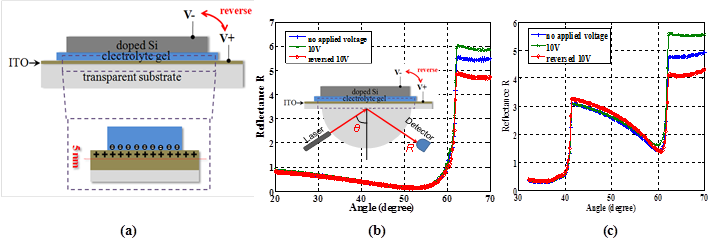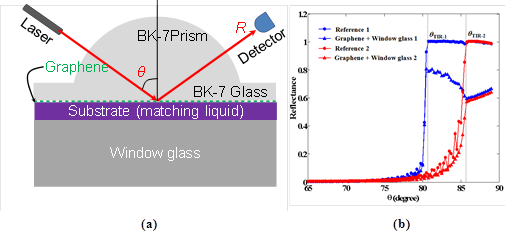58th Annual Report on Research 2013 Under Sponsorship of the ACS Petroleum Research Fund
Reports: DNI1050277-DNI10: Plasmon-Enhanced Light-Trapping for Thin-Film Solar Cells
Zhaolin Lu, PhD, Rochester Institute of Technology
Plasmon-Enhanced Light-Trapping for Thin-Film Solar Cells
Sponsor: ACS Petroleum Research Fund
(Award No. ACS PRF# 50277-DNI10)
Annual Project Report
September, 2012 - August, 2013
Zhaolin Lu
Microsystems Engineering, Kate Gleason College of Engineering
Rochester Institute of Technology
168 Lomb Memorial Drive, Rochester, NY 14623
This program is focused on increasing light harvesting in thin film solar cells by exploiting the light trapping effects of surface plasmons and photonic crystals. Most of the research was completed during pass two years, and only a small portion of the task is extended in last year. This research in last year has resulted in two journal papers, and two invited conference presentations, and three submissions. Most of the research results have been or will be published in journal or conference papers. Accordingly, this report only contains milestone data of research since September, 2012.
Indium-tin-oxide (ITO) is widely used as transparent electrode in solar cells and displays. The carrier concentration in ITO is in the range of 1019-1021cm-3 by manipulating the concentration of oxygen vacancies and interstitial metal dopants. The high carrier concentration enables guided surface mode at the interface of ITO and air, which has a great potential in the applications of electro-optic (EO) modulators. Graphene is also a desirable material in the advanced nanoelectronics. As being one atom thick, the weak absorption of monolayer graphene limits its applications in the field of nanophotonics. Our recent work based on the attenuated total refraction (ATR) method demonstrated: (1) active plasmonic metamaterial ITO for EO modulator application; (2) the optical absorption of monolayer graphene can be significantly enhanced up to 42.7% over a broad spectral range from visible to near infrared.
1. Active Plasmonic Metamaterials
Both experimental results are obtained based on an ATR setup in the Kretschmann configuration. The ITO-based EO modulators are illustrated in Fig. 1(a), where electrolyte gel is used in between either ITO and doped Si or two identical ITO samples. The 25nm-thick ITO on transparent glass slide is deposited by PVD process at room temperature. Its sheet resistance of ITO is around 3000-4000Ω/□. When applying an external voltage, at the interface of electrolyte gel and ITO, an electric double layer is formed. Figure 1(b) and (c) show the reflectance as a function of angle for the structures of ITO-gel-doped Si and ITO-gel-ITO at λ=1520nm with an s-polarized light, respectively. The modulation depth is around 21.7% for the modulator in Fig. 1(a). The modulation depth can be further enhanced to 29% when the doped silicon is replaced by another ITO sample, as the result shown in Fig. 1(c).
Figure1. (a) With an applied voltage, electric double layer is formed at the interface of ITO and gel. Reflectance as a function of angle for (b) ITO-gel-doped Si modulator, and (c) ITO-gel-ITO modulator. |
2. Greatly Enhanced Light Absorption by Monolayer Graphene
The ATR configuration is also used to greatly enhance light absorption by monolayer graphene. In our work, the monolayer graphene is sandwiched between two semi-infinite media, namely superstrate (BK-7 glass) and substrate with refractive indices nsup and nsub, respectively, as illustrated in Fig. 2(a). Based on our calculation, closer values between nsup and nsub will result in higher absorption, and the enhanced absorption can be achieved from the visible to near infrared regime for s-polarized light.
Figure 2. (a) The ATR configuration used to greatly enhance light absorption by monolayer graphene. (b) Measured reflectance of the monolayer graphene sandwiched between the prism and a window glass with a s-polarized incident light at λ=650nm. The blue (red) triangle curve is the result for graphene sandwiched between the prism and window glass 1 (window glass 2). The dotted curves are their corresponding control experiments with the same multilayer configuration but without graphene. |
The experimentally measured reflectance of the sample as a function of θ is shown in Fig. 2 (b). In Fig. 2(b), both the blue dotted and red dotted curves are the control experiments measured by replacing the graphene sample with a bare BK-7 glass slide. The absorption of monolayer graphene is greatly enhanced to be 40.5% (window glass 1) and 42.7% (window glass 2) at the critical angle. We also confirmed that the similar level of light absorption can be achieved from visible to the near infrared regime since there is resonator or cavity involved in this multilayer configuration.
3. Impact on PI's Career
Based on the results, the PI has received new grant from National Science Foundation. The PI is also preparing proposals to submit to other federal agencies, such as US Army and Department of Energy.
4. Impact on the Students
In addition to the PI, this project supported the six students to some degree. Two students have graduated and taken positions in industry. The research results have been incorporated in two courses: Optoelectronics and Integrated Optics.
5. List of Publications During Last Year <>(1) A. Kaur, S. Banerjee, W. Zhao, J. Venkataraman, and Z. Lu, “Deep Subwavelength Power Concentration Based Hyperbolic Metamaterials,” International journal of optics, vol. 2012, 879392 (6) (2012).
<>(2) W. Zhao, K. Shi, and Z. Lu, “Greatly Enhanced Ultrabroad Band Light Absorption by Monolayer Graphene,” accepted by Optics Letters.
<>(3) Z. Lu, W. Zhao, and K. Shi, “Active Plasmonic Metamaterials and Greatly Enhanced Light Absorption by Monolayer Graphene (invited),” Frontier in Optics 2013, Plasmonics and Nanophotonics, Orlando, Florida, USA.
(4) Z. Lu, K. Shi, and, R. R. Haque, “Nanoplasmonic waveguides and modulators for advanced optical interconnects (invited),” SPIE Photonics West 2014, San Francisco, CA, USA.
(5) K. Shi, W. Zhao and Z. Lu, “Epsilon-Near-Zero-Slot Waveguides and Their Applications in Ultrafast Laser Beam Steering,” SPIE Photonics West 2014, San Francisco, CA, USA (submitted).
(6) R. R. Haque, W. Zhao, R. Zhao, K. Shi, and Z. Lu, “Active plasmonic metamaterial based on transparent conducting oxide,” SPIE Photonics West 2014, San Francisco, CA, USA (submitted).
(7) K. Shi, W. Zhao, and Z. Lu, “Novel Approaches to Enhance Graphene Absorption and Electro-Optic Property,” SPIE Photonics West 2014, San Francisco, CA, USA (submitted).
Copyright © 2014 American Chemical Society













